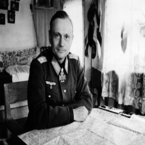M60A3TTS
Posts: 4014
Joined: 5/13/2011
Status: offline

|
Air Situation
At the beginning of October 1941 the VVS had 3,576 aircraft to an Axis total of 3,280. This amounted to a difference of under 300 machines. In the first sixteen weeks of war, the Red Air Force sustained losses averaging more than 1,000 aircraft per week.
A total of 285 air regiments and 4 battalions that the VVS possessed would, under a full complement, contain some 5,740 aircraft. The total available at the beginning of October amounted to just over 62% of full strength. There were 55 air units each with a complement of from 0-5 aircraft.
A breakdown of the aircraft in various combat units totaled 1,178 fighters and fighter bombers, 464 tactical bombers, 1,653 level bombers, 184 reconnaissance and 87 transport aircraft.
By this time, MiG-3 fighter production had ceased as the factories had been evacuated from Moscow. LaGG-3 production of 66 aircraft per week was concentrated in three factories of which two had absorbed bombing damage of 22% and 4% respectively. Three Yak-1 factories in the Saratov region had all received bomb damage at 30% 28% and 11%. Two of these plants would be evacuated to the Urals in the second week of October with the remaining factory following a week later. LaGG-3 series 11 production had been ended by an unexpected capture of the Taganrog factory.
The first shipments of Lend Lease aircraft arrived in early October in the form of 28 Hurricane II-Bs and 15 P-40Bs. These were to reinforce a fighter arm with precious few capable planes. There were at this time 105 MiG-3 aircraft in inventory to go with 82 Yak-1s. There were also just under 190 LaGG-3 aircraft, but these were really entry-level machines that normally would have gone to pilot recruits. They have a poor loss-kill ratio compared to more capable fighters and have earned their nickname “guaranteed varnished coffin.” The remaining 68% of the fighter complement consisted of various I-Type fighters.
In the tactical air category, it would be months before two MiG-3 factories evacuated from Moscow would convert to IL-2 production. The two IL-2 factories originally at Voronezh had departed the city in August and the SU-2 plant in Kharkov had been written off by German occupation of the city. Fortunately, with the exception of a single week, IL-2s were delivered by one or both of the Sturmovik factories now located at Izhevsk, far to the east. During some weeks fifteen aircraft would arrive and thirty in others. It would not be until mid-December that production would expand. The eight SU-2 regiments of the VVS would slowly see the aircraft numbers dwindle until IL-2 aircraft could be brought in as replacements.
Level bombers were the one category where the VVS still possessed reasonably good numbers in 94 regiments, but without fighter escort, they would be largely useless.
In transports, the Li-2 aircraft plants had been lost at Khimki near Moscow and it would be 1943 until American lend lease aircraft could be counted on to rebuild this category.
In reconnaissance planes, two-thirds of the SB-2R type had been expended. Pe-2R production was minimal, just a few units, so assorted inventories of outmoded aircraft would be counted on to fill in until inventories could be re-built.
On the basis of the size of the task to reconstruct the VVS, it was decided to keep shifting airframes to the National Reserve in times when their presence was not vital to operations on the ground. This would include a substantial portion of the winter period, particularly because level bombers have such a low participation rate in snow conditions.
After two months had passed as blizzard arrived in early December, the VVS could call upon 4,673 planes, an increase of over a thousand. Two months after that, another thousand were added to the inventory. Commanders on the ground were having to make due with minimal air support and to their credit they did so without complaint.
March 1942 was a period when the ground conditions permitted the Axis to return to the offensive, although under trying conditions. It was decided to commit the VVS to action, even though the earlier plan had been to hold it back to preserve numbers. In March, our fighter force suffered significant losses compared to production with totals of 1,005 lost and 654 built or delivered by our Anglo-American allies.
April saw a return of rain and muddy conditions and once again the VVS returned to rear areas to make good recent losses. By this time Yak-1 production was improving, although not yet at its full capacity of 75 units per week. This time fighter losses were significantly less than production, 251 lost and 892 added respectively. Total VVS losses by this time were over 19,500 aircraft compared to the loss of 3,100 Axis.
Throughout this period, improved versions of fighter bombers were reaching the force. The American P40B gave way to E models in January with less range but slightly better performance. Delivery rates did drop from fifteen aircraft per week to nine. The American P-39D also appeared in March, albeit at a very small rate of four per week. Domestically, the Yak-7A began production in January, to be followed by the Yak-7B in May. Full production of this aircraft was not expected until late July.
Airbases during this period remained a constant as SAD bases were replaced on a 1-1 basis by distinct unit types. More were expected to be added in the summer of ’42 to accommodate an expansion of air regiments.
The Axis air tactics clearly focus on taking the fight to Soviet airbases rather than the front lines. They have been quite successful to date with this approach, but it has also been during an extended period when quality Soviet fighter aircraft have arrived in modest numbers. An unwillingness to simply leave the field and permit the Axis to make even greater gains to the east accounts for some of our losses. While the buildup of the VVS may not be proceeding at a pace some think it should, the overall trend by the numbers is positive. The rises and dips in Soviet fighter numbers come regularly but the overall trend is a positive one, even by Axis calculations.
Ideas such as insuring adequate ready fighter aircraft prior to ending weekly Soviet air operations is something that has been happening for some time. So too has withdrawing lower morale air regiments. In fact, the overall morale of the VVS is quite good, and experience levels rather respectable.
1942 is a year of transition for the VVS and is well on its way at the start of June. The halcyon days of the Luftwaffe will in due time be replaced by a darkened sky as the shadows of our sturmoviks portend the coming Soviet storm.
|
 Printable Version
Printable Version




































 New Messages
New Messages No New Messages
No New Messages Hot Topic w/ New Messages
Hot Topic w/ New Messages Hot Topic w/o New Messages
Hot Topic w/o New Messages Locked w/ New Messages
Locked w/ New Messages Locked w/o New Messages
Locked w/o New Messages Post New Thread
Post New Thread